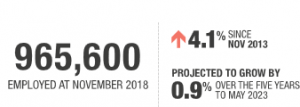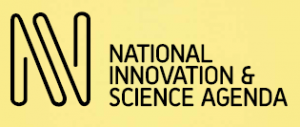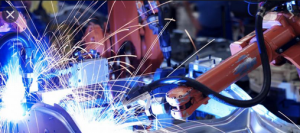Science, Technology and Manufacturing
This page explores the capacity of Australian science and technology to generate employment in manufacturing, through innovation policy.
The creation of wealth through the application of technology in a market economy is central to material progress.
Adding value through invention, design and all aspects of products that build a respected brand is central to environmental sustainability – as it generates many orders of magnitude more economic value per unit of natural resource consumed.
To the best of my knowledge, Australia has a good National Science and Innovation Agenda in the early stages of implementation. It is based on extensive analysis presented in reports by Innovation and Science Australia (see below), composed of scientists and industry leaders. This page also contains several other more specialised reports on Australian manufacturing and related scientific research. The overall pattern in these reports is one of frustration at repeated failures to commercialise Australian technology, combined with more optimistic accounts of developments over the last five years.
A powerfully argued case for the social and employment benefits of technological innovation is presented in the excerpts from the executive summary of the Innovation and Science Australia (ISA) report ‘Australia 2030: Prosperity through Innovation’ (see below).
While automation may indeed eliminate many jobs, doing nothing about advanced manufacturing risks ending up with the worst of both worlds: job losses through unavoidable technological change, combined with failure to capitalise on Australia’s research strengths.
Labour’s Manufacturing Future Fund (proposed at the 2019 election) is also included below. The approach is based on that of the Clean Energy Financing Corporation (CEFC), and includes co-investing/leveraging private investment (i.e. matching private investment with government investment or concessional loans).
This approach has been very successful adopted by the CEFC, and could be complementary to the National Science and Innovation Agenda introduced by the Turnbull government. A bipartisan approach of building on achievements of previous administrations could well be a formula for success.
While the sums to be invested are substantial, they are tiny on the context of the stimulus packages in response to the GFC and Covid 19.

Current Manufacturing Employment
https://australianjobs.employment.gov.au/jobs-industry/manufacturing
Manufacturing

Following decline for much of the past decade, Manufacturing employment has grown strongly over the past year and this industry continues to provide a significant number of jobs.
The largest employing sectors are Food Product Manufacturing (220,900 jobs) and Machinery and Equipment Manufacturing (124,200). Employment in this industry is typically full-time (84%).
Holding a certificate III or higher vocational qualification is common in this industry, and there are opportunities to undertake training (with 23,700 apprentices and trainees employed in this industry in 2018).
Manufacturing employment is projected to rise slightly over the five years to May 2023 (up by 0.9%), with the Fabricated Metal Product Manufacturing sector projected to have the strongest growth (up by 10.6%).
Innovation and Science
national-innovation-and-science-agenda-report


[Edited Excerpts]
A world of change
The pace of change, supercharged by new and emerging technologies, has never been so great, nor
so disruptive. It is being driven by rapid advances in computer processing power and data storage capacity, with
an average smartphone more powerful than the combined computing power of NASA in 1969.
The Internet is also disrupting traditional jobs, businesses and industries in a manner that would have
been unimaginable just a few decades ago.
The Internet is breaking down barriers to entry and presenting an enormous platform for innovation.
Although the Internet exposes more local businesses to new sources of competition, it also means that a
larger and far wealthier global market has become accessible to Australia.
At the same time, economic convergence means countries that had, until recently, competed for low
cost, low skill jobs are now competing for the most skilled and producing the most advanced products.
For Australia this is both a threat and opportunity.
Competition for market share is fiercer than at any point in history but it also means that more consumers
have burst into the middle class. Much of this growth has been and will be in our region
— in the next 15 years China and India together will be home to over 2.3 billion middle class consumers.
Innovation for jobs and growth
While historically high commodity prices have driven the growth in our living standards over the last decade,
fostering innovation and commercialising ideas will be a key driver of future jobs and growth.
Innovative firms are more competitive, more able to capture increased market share and more likely to
increase employment than their competitors. Over the period 2006-2011, 1.4 million new jobs were created by
firms aged less than three years old. Employment in mature businesses, in contrast, fell 400,000.
The role of government
Government supports innovation by investing in enablers such as education, science and research, and
infrastructure; incentivising business investment; and removing regulatory obstacles such as restrictions
around employee share ownership or access to crowd-sourced equity funding.
The Government is investing around $9.7 billion in research and development in 2015-16. Around $3.2 billion directly supports business sector R&D and much of the rest funds research in universities and research agencies such as CSIRO.
Government also enables innovation by investing in traditional infrastructure such as research laboratories,
roads and rail and digital infrastructure such as the nbn, which currently passes 1.5 million premises, with
construction to begin in areas covering almost 7.5 million premises over the next three years.
Boosting innovation and science in four key areas

Only 9% of Australian small to medium sized businesses brought a new idea to market in 2012-13,
compared to 19% in the top five OECD countries.
We will provide new tax breaks to remove the bias against businesses that take risks and innovate,
and we will support greater private sector investment by co-investing to commercialise promising ideas through a CSIRO Innovation Fund and a Biomedical Translation Fund.
![]()
Australia’s rate of collaboration between research and industry sectors is the lowest in the OECD. We
need to encourage Australia’s world-class researchers and businesses to collaborate to shape our future
industries and generate wealth.
We will change funding incentives so that more university funding is allocated to research that is
done in partnership with industry; and invest over the long term in critical, world-leading research
infrastructure to ensure our researchers have access to the infrastructure they need.
![]()
Too few Australian students are studying science, maths and computing in schools – skills that are critical
to prepare our students for the jobs of the future. We also need to create an environment that attracts the
world’s best talent to our shores.
![]()
We will lead by example by becoming more innovative in how we deliver services and make data
openly available to the public and make it easier for startups and innovative small businesses to sell
technology services to government.
We will place innovation and science at the centre of the Government with a new sub-committee of
Cabinet, and will establish Innovation and Science Australia as an independent advisory board.

This Agenda . . . builds on key measures we have already put in place,
including:
- Establishing Industry Growth Centres in key sectors of competitive advantage: Advanced Manufacturing; Food and Agribusiness; Medical Technologies and Pharmaceuticals; Mining Equipment, Technology and Services; and Oil,
Gas and Energy Resources - Reforming employee share schemes to allow startups to attract world leading staff
- Delivering tax cuts through the $5 billion Small Business and Jobs Package
- Delivering the Entrepreneurs’ Programme to help our entrepreneurs get off the ground
- We will make innovation central to all our major policies going forward. This will include a focus on
innovation in the Defence White Paper and the Tax White Paper
Funding Startups
We need to improve the availability of finance for our innovative startups. The period between initial funding to
when a startup begins generating revenue is known as the ‘valley of death’. During this time additional financing
is usually scarce, leaving the business vulnerable to cash flow requirements.
Around 4,500 startups miss out on equity finance each year and access to additional finance is one of the main
barriers to growth that startups face. Innovative businesses that don’t have a track record and that are not
following a proven methodology can find it particularly difficult to raise finance from traditional sources. Early
stage investors, whether individuals or companies, can play a key role, both in providing direct investments and in
contributing their business experience.
The venture capital industry is gaining momentum in Australia, with over $600 million raised or planned since
30 June 2015. Confidence in early stage start up activity is strong, but this is primarily concentrated in the
technology sector. It’s important that we build on this momentum, improving funding for promising projects
right across the economy.
The measures in this package will address this funding gap and help ensure a steady flow of investment
opportunities through to later stage venture capital investors.

New initiatives
We are aligning our tax system and business laws with a culture of entrepreneurship and innovation.
- We will provide new tax breaks for early stage investors in innovative startups. Investors will receive
a 20% non-refundable tax offset based on the amount of their investment, as well as a capital gains tax
exemption. This scheme is based on the successful Seed Enterprise Investment Scheme in the United
Kingdom, which has resulted in over $500 million in funding to almost 2,900 companies in its first two years. - We will build on the recent momentum in venture capital investment in Australia including by
introducing a 10% non-refundable tax offset for capital invested in new Early Stage Venture Capital Limited
Partnerships (ESVCLPs), and increasing the cap on committed capital from $100 million to $200 million for
new ESVCLPs. - We will relax the ‘same business test’ that denies tax losses if a company changes its business activities,
and introduce a more flexible ‘predominantly similar business test’. This will allow a startup to bring in an
equity partner and secure new business opportunities without worrying about tax penalties. - We will remove rules that limit depreciation deductions for some intangible assets (like patents) to a
statutory life and instead allow them to be depreciated over their economic life as occurs for other assets. - We will also reform our insolvency laws, which currently put too much focus on penalising and stigmatising
business failure. The Government understands that sometimes entrepreneurs will fail several times before
they succeed – and will usually learn more from failure than from success. Accordingly, we will:
• reduce the default bankruptcy period from three years to one year;
• introduce a ‘safe harbour’ for directors from personal liability for insolvent trading if they appoint a
professional restructuring adviser to develop a plan to turnaround a company in financial difficulty; and
• ban ‘ipso facto’ contractual clauses that allow an agreement to be terminated solely due to an
insolvency event, if a company is undertaking a restructure.

[Image from ‘Australian bioengineering inspirations, from the pacemaker to the bionic eye’, Chris Sheedy July 23 2019: https://www.createdigital.org.au/australian-bioengineering-inspirations-pacemaker-bionic-eye/]
We will back high potential ideas with capital to help ensure they stay and grow in Australia.
- We will establish a new $200 million CSIRO Innovation Fund to co-invest in new spin-off companies and existing startups that will develop technology from CSIRO and other publicly funded research agencies and universities.
- We will establish a new Biomedical Translation Fund to co-invest $250 million with the private sector to increase the capital available for commercialising medical research within Australia and help ensure that our deep strengths
in this area are leveraged to drive future growth.
Employee Share Schemes – attracting/rewarding talent
We have introduced generous tax concessions for startups who reward their staff through employee share schemes, allowing them to compete with established companies and to attract the best talent from overseas.
Crowd-sourced equity
We have also introduced legislation to allow new companies to attract financing through crowd-sourced equity. The scheme allows companies to raise up to $5 million per annum through this mechanism, which compares favourably to other countries such as the United States (US$1 million p.a.) and New Zealand (NZ$2 million p.a.).
Connecting SMEs with Research
We will also connect more small and medium businesses with researchers by expanding and relaunching
the successful Research Connections programme as Innovation Connections, opening up Australian
Research Council Linkage Projects to continuous applications to fast track decisions on collaborative
research grants, and opening a new application round for the Cooperative Research Centre programme in
February 2016.
Linking to the world
We will increase linkages with key economies to enable Australia to improve research, commercialisation
and business performance, and access international supply chains and the global market. This will include
providing access for entrepreneurial Australians to landing pads in Silicon Valley, Tel Aviv and three other
locations, and leveraging the expertise of the Australian diaspora in key markets. We will also provide
funding for Australian collaborations with international research-industry clusters, such as Leading-Edge
Clusters and Fraunhofer Institutes in Germany.
Investing in the future of information technology
We will establish a new Cyber Security Growth Centre to create opportunities for Australian businesses in
this critical new sector. We will boost Australia’s world class capability in quantum computing research by
investing $26 million towards building a silicon quantum circuit, with the potential to create new jobs and
new business models.
STEM in Schools
To ensure that our young people have the skills they need for the future, the Government has been leading nationally by calling for and working with the States and Territories on a national STEM School Education Strategy.
In September 2015, the Australian Curriculum was endorsed by the COAG Education Council. The Curriculum includes a digital technologies element – and the Government has reinforced this with $3.5 million for teaching coding, as part of the $12 million restoring the focus on STEM in schools in 2014.
STEM for Curious Minds
As part of an Australian Government funded initiative, 54 school girls will be brought to Canberra in December for the first national all-girls Curious Minds STEM extension learning and mentoring programme. School girls from diverse backgrounds will spend four days learning science, informatics and mathematics, mentored by inspiring
women in science, including Professor Angela Moles (2013 Life Scientist of the Year), and young innovators such as Microsoft’s Esther Mosad.
science_and_research_priorities_2015
[Edited excerpts]
The Government has established a set of Science and Research Priorities, and corresponding Practical Research Challenges, designed to increase investment in areas of immediate and critical importance to Australia
and its place in the world.
Our Industry Innovation and Competitiveness Agenda states that we will align Australia’s research priorities with our comparative advantages and our Boosting the commercial returns from research paper calls for national
science and research priorities and corresponding practical challenges.
Led by the Chief Scientist, Professor Ian Chubb AC, the Priorities and associated Practical Challenges were developed in consultation with researchers, industry leaders and government representatives.
The research priority areas are: Food, soil and water, transport, cybersecrity, energy, resources, advanced manufacturing, environmental change and health (not in any order of priority)
australia-2030-prosperity-through-innovation-full-report
Excerpt from Foreword: Bill Ferris AC, Chair of Innovation and Science Australia (ISA) Board
Australia’s tyranny of distance made inventiveness a necessity for early colonists, inspiring the stump‑jump plough, which enabled broad‑acre farming, and refrigeration, which allowed meat to be exported. Over the last century, Australia has produced 15 Nobel Prize winners, mostly for knowledge breakthroughs in medicine and physiology.
However, Australia has also failed to capture the full value of our many inventions; the black box flight recorder,
heart pacemaker, photovoltaic cells, X‑ray crystallography and many others were all based on Australian research breakthroughs, but commercialised overseas. Looking towards 2030, innovation will be integral to the expansion of Australia’s economy, keeping its workforce strong, and addressing societal challenges.
Recognising the importance of innovation for Australia’s future, the Australian Government established the Innovation and Science Australia (ISA) Board in 2016, made up of 15 entrepreneurs, investors, researchers and educators with extensive local and global experience. The board was asked to produce a strategic plan to advise
policy makers on how to accelerate innovation and optimise Australia’s innovation system out to 2030.
The ISA Board is confident that Australia can become a top‑tier innovation nation by 2030 . . .
Excerpts from executive Summary
Innovation will shape opportunity in Australia by 2030
Innovation is essential to create more economic and social opportunities for Australians by 2030. With the resources investment boom easing, and our population ageing, Australia needs to find new sources of growth and improve productivity to maintain our standard of living.
Growth opportunities
The biggest growth opportunities will come from knowledge intensive companies that innovate and export,
as they are the most profitable, competitive and productive. These companies will increasingly need to solve global problems at scale. When they succeed, they will make a substantial contribution to new jobs growth in Australia.
This will come through both direct employment and indirect jobs throughout the economy from companies in their supply chain or in the service economy for their workers.
Employment trends
Innovation will also be critical to the employment market in Australia in 2030. Despite present fears about automation eradicating jobs, by 2030 a shortage of workers is a more likely problem than a shortage of jobs. Australia’s ageing population means a retirement boom is looming, which will create a 6 per cent shortfall
in the number of workers needed to maintain current gross domestic product (GDP) growth in 2030.2 Innovation and digital technologies such as automation will help fill Australia’s future labour gap, by improving productivity and
performing tasks workers do not want, or need, to do.
In addition, the types of jobs available, the skills needed to do them, and the length of employment will change. Automation will continue to replace some manual, routine tasks performed by workers, disproportionately
affecting traditionally strong sources of employment, such as drivers and clerical administrators. Simultaneously, technology will create new roles in fast‑growing fields like professional and technical services.
Future Job Skills
The skills people will need to do their jobs will also evolve; 92 per cent of future jobs will need digital skills, and 45 per cent of jobs will need people who can configure and work confidently with digital systems and technology. More jobs will demand 21st‑century skills, such as interpersonal skills, entrepreneurialism and hypothesis-based
problem solving.
People will also change jobs more frequently. An Australian student leaving school today is likely to have five careers and 17 jobs over their working life. Education and outlook will determine how well Australians adjust to these new work opportunities. Every Australian child should have access to a world‑class education to give them the best start in life. That education must include a foundation of core and 21st‑century skills, a progressive accumulation of knowledge in subjects such as maths to maximise the choice of advanced subjects in later study, and a motivated learner’s mindset. Existing workers will depend on the education system to help them retrain and upskill more often to win well‑paid jobs and smoothly navigate career transitions.
Social Benefits
Innovation will also change Australian’s lives for the better by 2030. Advances in technology – from genomics, to data analytics and materials science – will enable breakthrough discoveries. This will span areas as diverse as
personalised health care, disaster management, and energy and transport solutions. Australia is at the forefront globally of many of these opportunities, aided by significant government investment in research and our world‑class pool of researchers. This work will have a profound impact on Australian lives. It means by 2030, for example, the 650 Australian children diagnosed with cancer each year are more likely to receive potentially life‑saving personalised treatment.
Australia’s innovation imperatives
Australia should be confident, but not complacent, that we can be at the forefront of the global innovation race and reap the opportunities this brings. We have a strong economy, and have shown we can launch globally successful companies in new, high growth industries.
This includes Cochlear Ltd and ResMed in medical devices, CEA Technologies in advanced radar, Austal in high-speed ferries and ships, Marand Precision Engineering in advanced manufacturing, and Atlassian in software. Our services sector, which employs 80 per cent of all Australians, has a robust track record of creating plentiful high-value jobs. And Australia has repeatedly demonstrated we can create game-changing inventions such as the world’s first cancer vaccine, Gardasil. However, to realise future opportunities in Australia, we need to make Australia one
of the best places in the world in which to undertake innovation, science and research, and to maximise the spread of benefits to all Australians.
For the 30 Recommendations of the Plan, see Figure 2 Overview of the 2030 Plan, p 4.
performance-review-of-the-australian-innovation-science-and-research-system-isa
Performance Review of the Australian Science and Innovation System, Innovation and Science Australia, 2016
Aust Science and Manufacturing
A selection or articles on Australian scientific and manufacturing capability
Manufacturing in Australia: Reports
171013_Australian_Manufacturing_Future_Fund
AUSTRALIAN MANUFACTURING FUTURE FUND
Labor’s plan for advanced manufacturing [edited excerpts]
A Shorten Labor Government will establish a new $1 billion Australian Manufacturing Future Fund (AMFF) to drive innovation and help Australian manufacturers grow their businesses and create new jobs.
Modelled on Labor’s successful Clean Energy Finance Corporation (CEFC), the AMFF will leverage finance in order to help Australian enterprises make the successful transition into high value production. This in turn will create high-skill jobs, support firms linking in to global supply chains and diversify the Australian economy.
Labor wants Australia to be a successful advanced manufacturing nation.
Whether it is auto component manufacturers re-tooling or diversifying into other industries, food manufacturers investing in new equipment to package new products for Asian export markets, or metals fabricators making the move into pre-fabricated housing, Labor’s AMFF will help our local manufacturers innovate, diversify, and develop opportunities in new export markets.
Building on the success of the CEFC, the AMFF will continue Labor’s work in developing an innovative nation for the future, and backing our comparative advantages in design, engineering, research and development.
Building on Labor’s success with the CEFC
The CEFC facilitates investment in new clean energy businesses and projects, which the private sector has been reluctant to fund due to the risk profile. The CEFC does so in partnership with private finance, using its investment to attract other capital and reduce the risk profile of new investments.
A Shorten Labor Government will establish the AMFF and model it on the CEFC. In its first four years of operation, the CEFC had committed $4.3 billion across 79 transactions with a total project value of $11 billion. Importantly, each dollar of CEFC investment 2016-2017 was matched by more than $2 from the private sector. In addition, unlike grant programs that negatively impact the budget the CEFC generates a rate of return for the Australian taxpayer.
How the AMFF will work
The AMFF will not seek to displace the private sector; it will look to address instances where high barriers to finance exist for manufacturers. Investment by the AMFF will lower the risk profile of projects, which in turn attracts private capital.
The AMFF will not issue direct cash grants to manufacturers. Rather, it will offer financing arrangements including, but not limited to, equity, concessional loans and loan guarantees. Consistent with the CEFC, the AMFF’s investment decisions will be guided by a public policy objective, and constrained by a clear investment mandate.
In Government, Labor will undergo a consultation process to finalise the investment mandate.
Upon establishment, a Labor Government would, via the Board, request that the AMFF prioritise consideration of transformative investments in both the automotive manufacturing and food manufacturing sectors. There may also be scope for the Fund to partner with the CEFC to invest in energy efficient projects and equipment to reduce a firm’s energy bills, or the Export Finance and Insurance Corporation (EFIC) to access new export markets with new products. The AMFF will be expected to actively work with Australian manufacturers to identify potential opportunities for growth, and apply commercial rigor when making its investment decisions, including focusing on projects at the later stages of development. By adopting a commercial approach, it is expected that the Corporation will invest responsibly and manage risk so it is financially self-sufficient and achieves a benchmark rate
of return. This benchmark rate of return will be expected to be met across the whole portfolio of the Corporation’s assets, not by any specific asset.
Other advanced economies support their SMEs and manufacturers in a similar way.
• The UK has a suite of schemes and funds dedicated to providing finance for their
private companies.
• Canada has a Business Development Bank The European Union has the European
Fund for Strategic Investments which, among other things, seeks to overcome
market failures by mobilising private investment as well as providing risk finance for
small businesses
Manufacturing Briefing Paper FINAL
Manufacturing (Still) Matters: Why the Decline of Australian Manufacturing is NOT Inevitable, and What Government Can Do About It
By Jim Stanford Centre, for Future Work at the Australia Institute June 2016
Many interesting points on sector strategies; industry networks, ecosystems and clusters [aka learning hubs]; tax incentives, investment vehicles, leveraging procurement and industrial infrastructure
Future_of_Manufacturing_Willox_address_Vernier_Society_Nov2019
Speech by Innes Willox of Australian Industry Group
Some interesting examples of traditional manufacturing firms retooling towards more advanced manufacturing, some supported by government programs.
17-00480_SER-FUT_IndustryRoadmapSummary4pp_AM_WEB_171109
CSIRO Roadmap for Advanced Manufacturing in Australia
Summary document giving key points of this report.
IndustryRoadmap_AdvancedManufacturing
The full report – contains technical analysis of Australia’s comparative advantages, coverage of specific industries/technologies and trends in manufacturing (including a section on sustainable manufacturing)
